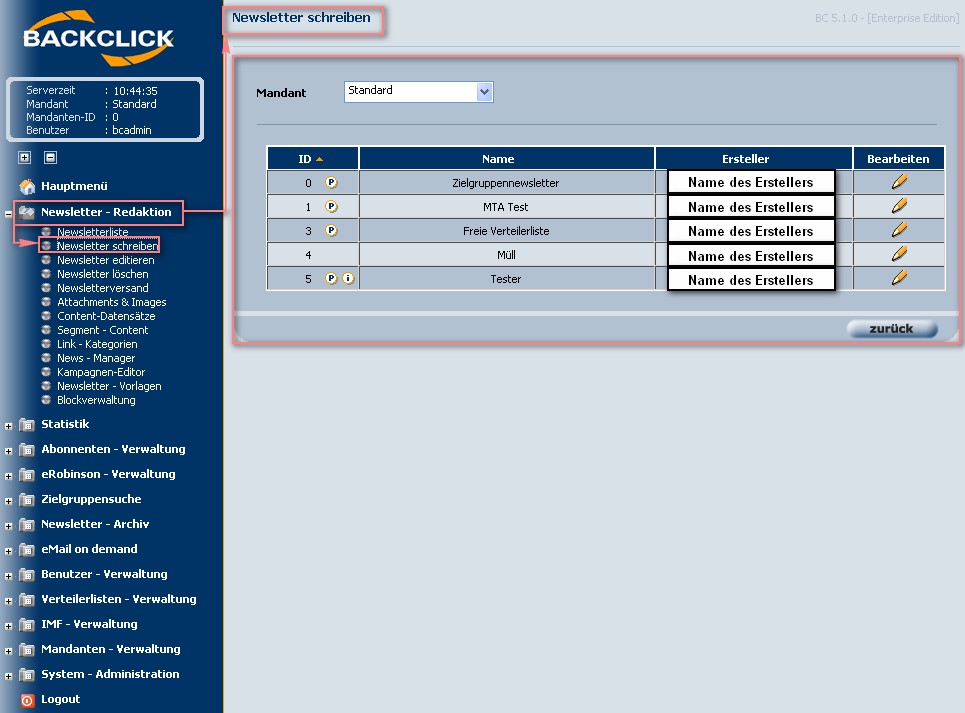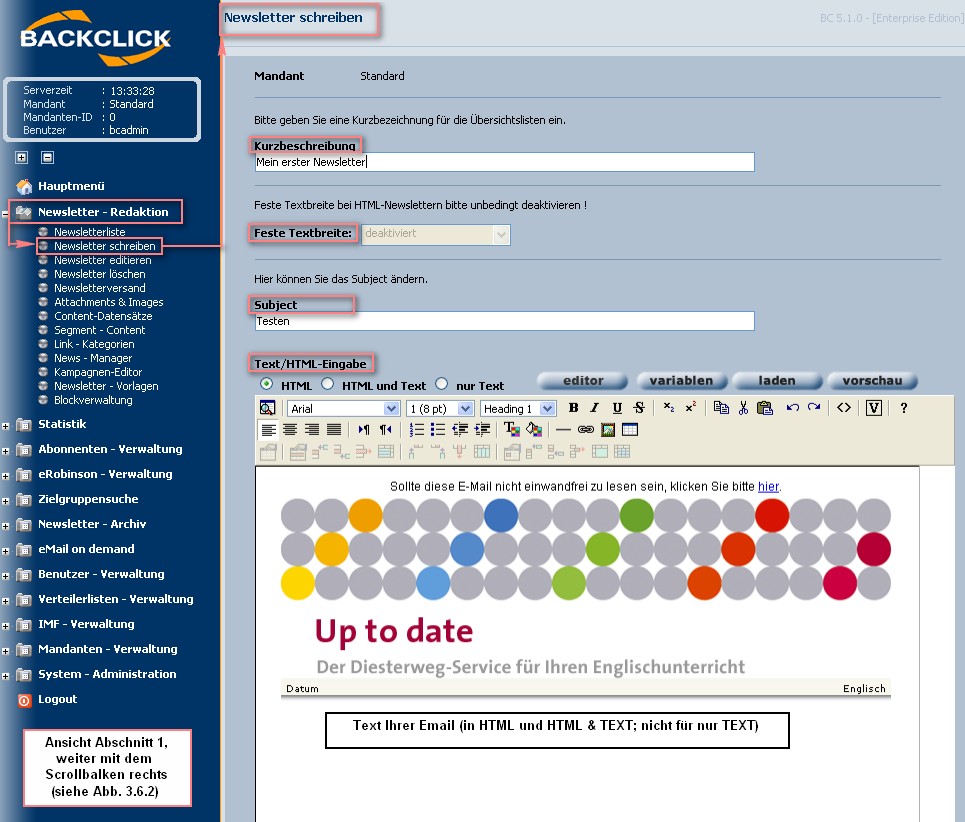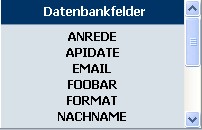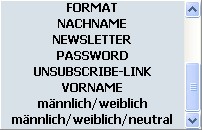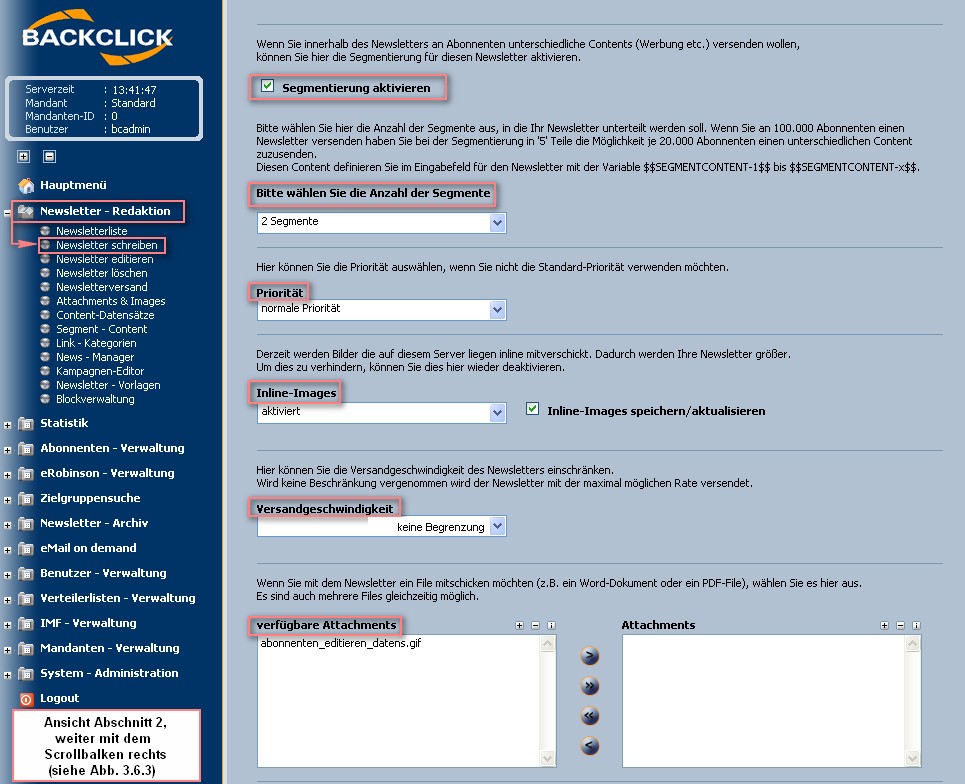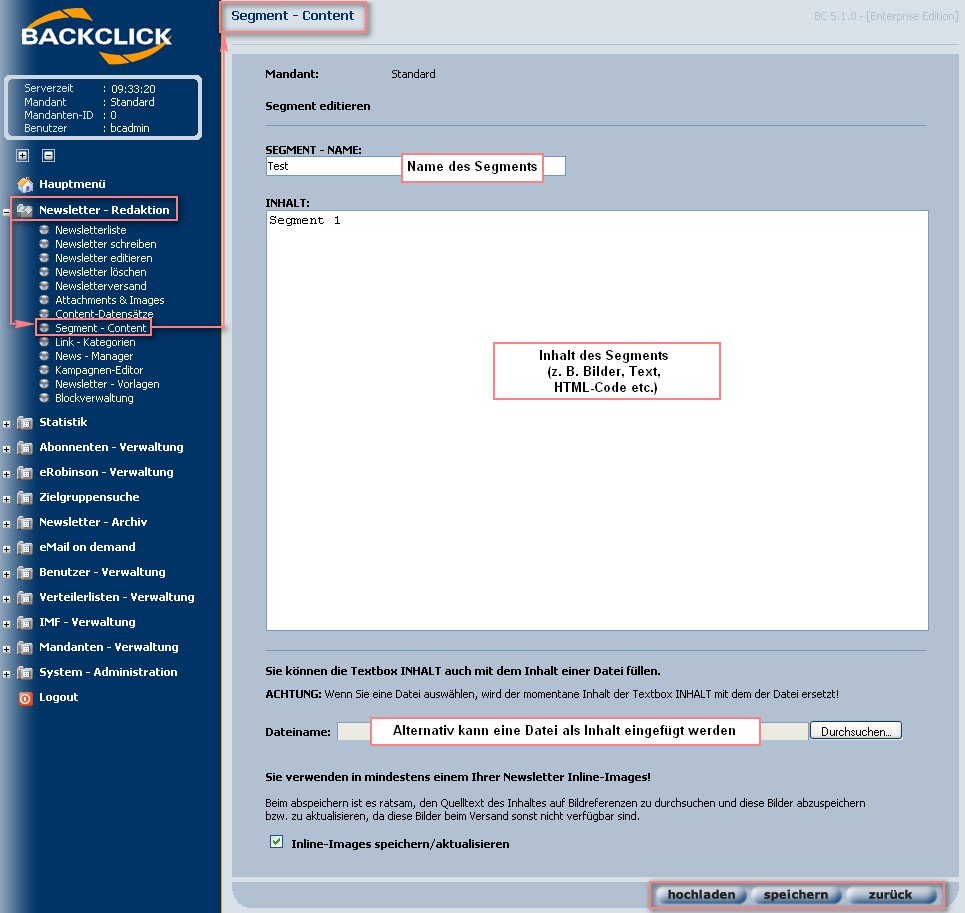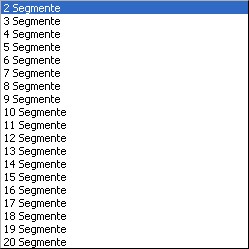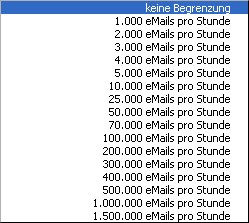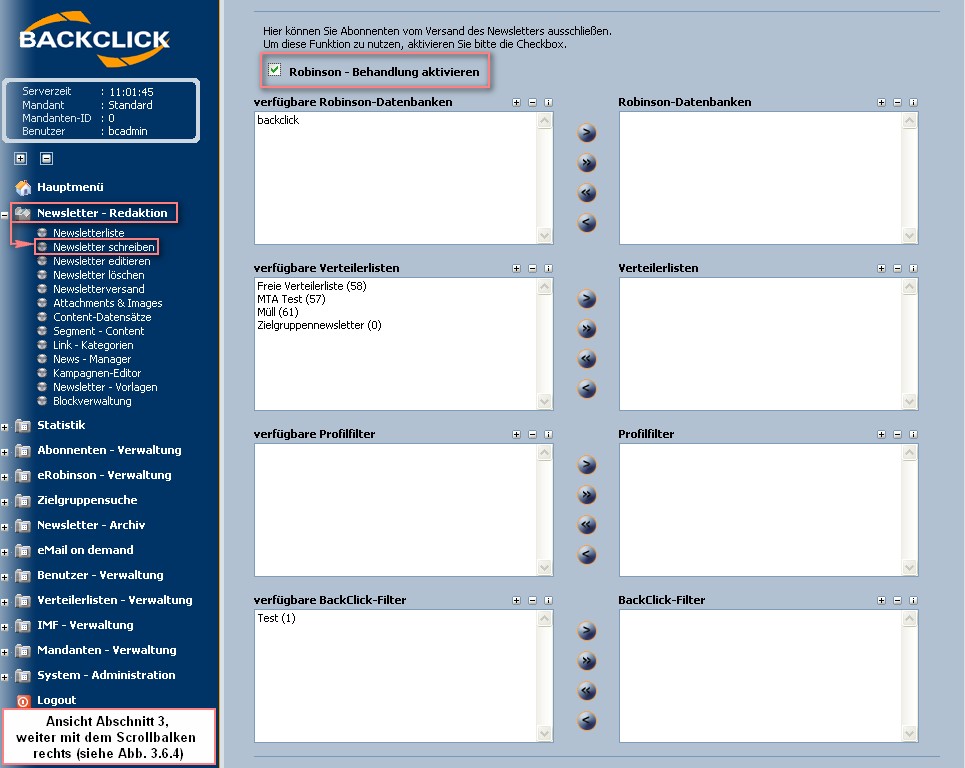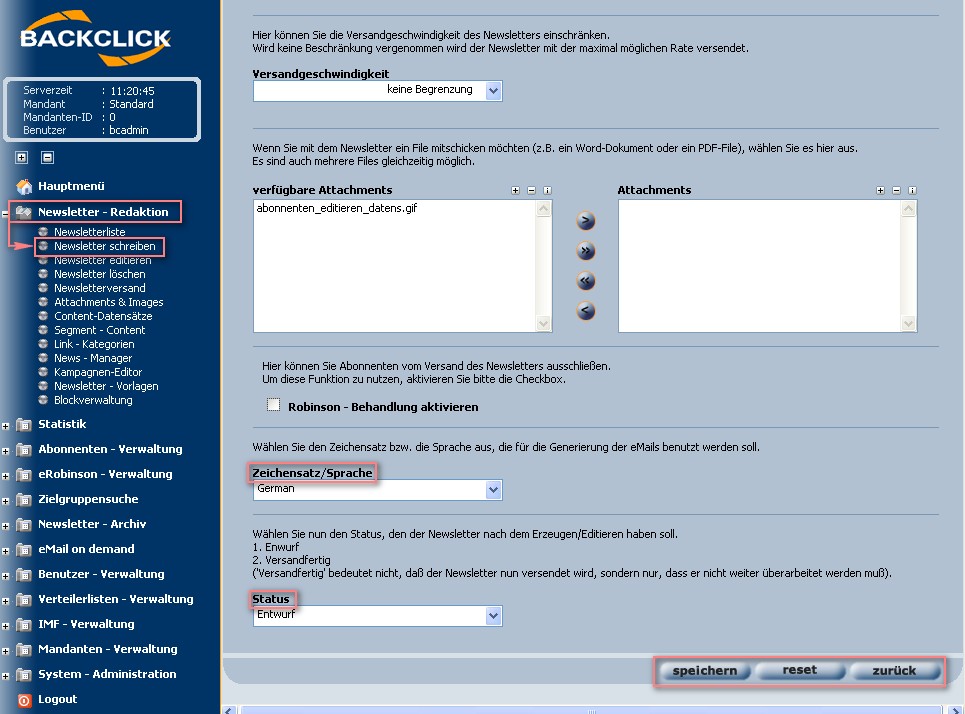Create the first newsletter
Now that you have followed the preliminary steps, you are ready to create your first newsletter. You have defined the basic settings: a minimum of one mailing list and one subscriber in your database.
Click on “Campaign Management -> Create New Campaign”. You will see an overview of the mailing lists you can work on. If you do not see a mailing list, you either cannot work on the existing mailing lists, or there is no mailing list in your system. If this happens, please ask your system administrator for further information.
If you see the overview:
Abb. 3.6 - Newsletter schreiben (1)
you may now choose the mailing list for the newsletter you want to create. For this example, we chose the mailing list “tester” ID 5. Please click on this -Symbol to get the entry mask:
Abb. 3.6.1 - Newsletter schreiben (Beispieleingaben)
Campaign description
Please enter a short description of your newsletter here. It will be used for listing the newsletter in the Administrative menu. If you want to write more than one newsletter for this mailing list, you may differentiate between the newsletters by using this description.
Fixed text width
You may define the maximum text width (the width of each line) of newsletters here. This is only necessary for “text-only” e-mails. The newsletter will then be formatted according to your definitions.
Subject
The subject of your newsletter should be entered here. All of the placeholders or variables you defined in your database designer may be used here.
Insert or edit text/HTML
Type of newsletter — check box: Before entering the content of your newsletter, you must decide whether you would like the newsletter to be text or HTML. You may also choose both options (“Multipart”). You may choose between:
- HTML
- HTML &Text (Multipart)
- Text
The following example will show you how to write an HTML newsletter. After you have chosen the type of newsletter you want to write, you will see an “Editor” that may be used. You can use “drag and drop” to add content to an HTML newsletter from Outlook and Outlook Express. You will be able to edit this material if you wish to do so.
Choose template
Several newsletter templates
come preinstalled in BACKCLICK. They may be edited if needed, and you can also create new templates. All of these templates are managed in the “Campaign Management -> Campaign Templates” menu selection. To edit a particular template, click the in the HTML editor. This will open a separate window, which will show you all the templates that you may work on.
You will see a preview if you click on the (). You can open the template directly by clicking on the -Button. This will open the template in your HTML editor; it may then be used for the newsletter.
Personalization and Variables
As seen in the Figure this newsletter already contains replaceable characters for personalization. Every variable you defined in your database designer may be used here. Clicking on will open the following “Select” box:
Abb. 3.6.2 - Newsletter schreiben (Beispieleingaben)
Segmentation/number of segments
To send different contents to different subscribers of the campaign, you may replace parts of your newsletter by $$SEGMENTCONTENT-1$$ and define a content for these segments. The number of segments is not restricted by BACKCLICK. The entry mask can be found in the menu “Campaign-Management -> Segment Content”.
Abb. 3.6.2.1 - Segment-Content festlegen
You also must choose the number of segments into which your newsletter should be divided. For example: You want to send a newsletter to 100,000 subscribers, and choose “5” segments in your settings. BACKCLICK will now divide your subscriber list into five blocks, with 20,000 subscribers per block. You may now define a different content for each block. The following segments are selectable:
Priority
This is where you may choose the priority of your newsletter, which should be shown in the e-mail client of your subscriber. The following options are selectable:
Inline-Images
When writing an HTML newsletter, you may use this function to send pictures or figures within the body of your newsletter. The advantage here is that pictures may make it more likely that the subscriber will print out the newsletter and read it off line. The disadvantage is that your newsletter will grow in volume, so that the subscriber has to wait much longer for the e-mail client to download the newsletter. Also, the subscriber’s e-mail server may filter out your e-mails due to spam suspicion. As a result, you should only activate this function if you can somehow exclude these disadvantages.
Speed limit
Here you may set a speed limit for sending your newsletters. This will reduce the number of newsletters that BACKCLICK will send out every hour after sending has begun. If you do not want to reduce the number of newsletters sent per hour, BACKCLICK will try to use the maximum rate for sending. The following options may be selected:
Attachments
Here you may add as many attachments to your newsletter as you like. Mark the desired attachment listed in the box that says “Available attachments”, and click on the -Button. The chosen attachments are now shown in the box on the right, labeled “Attachments”. If there are no selectable attachments in the box, you may complete the settings for this newsletter, and provide BACKCLICK with the necessary data afterwards (see “Attachments & Images”).
Abb. 3.6.3 - Newsletter schreiben (Beispieleingaben)
Activate eRobinson-handling
You may activate this function to exclude particular subscribers from a newsletter mailing. Possible reasons to exclude these subscribers may be:
- E-mail addresses from an external database
- E-mail addresses that do not fit into target groups because of special criteria
- E-mail addresses that responded to special selections
- E-mail addresses of another mailing list in BACKCLICK
Activating this function will open eight selection boxes. To exclude the subscribers, select the entries in the left box, and confirm them by clicking on the -Button(now shown in the right box).
Abb. 3.6.4 - Newsletter schreiben (Beispieleingaben)
Charset/Language
You will need to select the charset/language that should be used to correctly display the letters of the newsletter in the e-mail client of the subscriber.
Status
After you have set all the information and contents of your newsletter, you may choose between two workflow statuses. If the status is set on “Draft,” no one can initiate sending the newsletter. If the status is set on “Ready for publishing,” you will find this newsletter in the “Campaign Overview”
Anyone who is authorized to access this newsletter may start sending it immediately, or define a date when it is to be sent. When all the necessary settings are complete, you may click on to save your settings and contents. The newsletter will then be shown in either “Edit Existing Campaign” or “Publish Campaign.”
